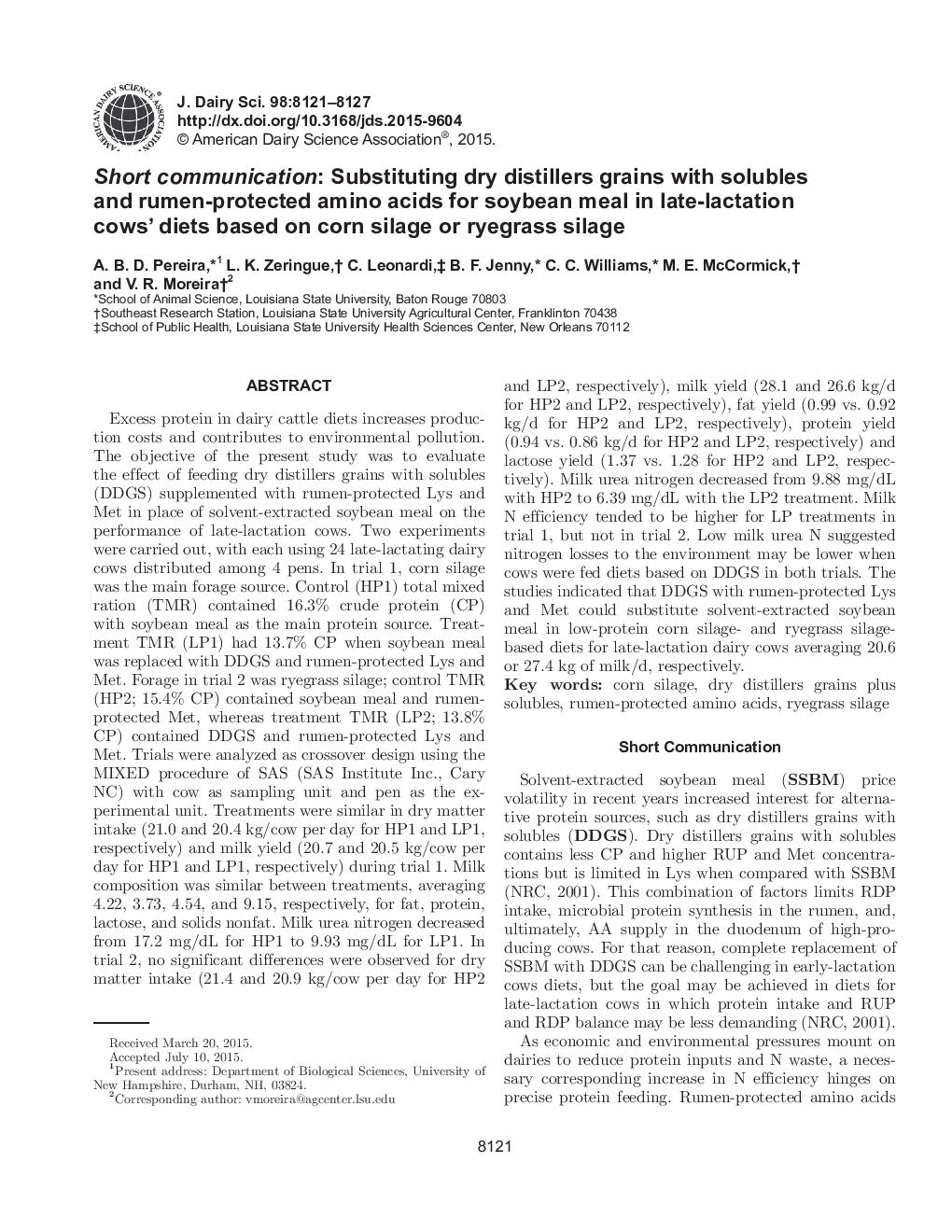| کد مقاله | کد نشریه | سال انتشار | مقاله انگلیسی | نسخه تمام متن |
|---|---|---|---|---|
| 10974581 | 1108026 | 2015 | 7 صفحه PDF | دانلود رایگان |
عنوان انگلیسی مقاله ISI
Short communication: Substituting dry distillers grains with solubles and rumen-protected amino acids for soybean meal in late-lactation cows' diets based on corn silage or ryegrass silage
ترجمه فارسی عنوان
ارتباطات کوتاه: جایگزینی دانه های تقطیر خشک با محلول ها و اسیدهای آمینه اسیدهای محافظت شده با شکمبه برای وعده های سویا در رژیم های گاوهای دیر شیردی مبتنی بر سیلوی ذرت یا سیلوهای ریگه
دانلود مقاله + سفارش ترجمه
دانلود مقاله ISI انگلیسی
رایگان برای ایرانیان
کلمات کلیدی
سیلاژ ذرت، غلات سبوسدار خشک به همراه محلول، آمینو اسید محافظت شده با شکم، سیلیس ریهگرا
موضوعات مرتبط
علوم زیستی و بیوفناوری
علوم کشاورزی و بیولوژیک
علوم دامی و جانورشناسی
چکیده انگلیسی
Excess protein in dairy cattle diets increases production costs and contributes to environmental pollution. The objective of the present study was to evaluate the effect of feeding dry distillers grains with solubles (DDGS) supplemented with rumen-protected Lys and Met in place of solvent-extracted soybean meal on the performance of late-lactation cows. Two experiments were carried out, with each using 24 late-lactating dairy cows distributed among 4 pens. In trial 1, corn silage was the main forage source. Control (HP1) total mixed ration (TMR) contained 16.3% crude protein (CP) with soybean meal as the main protein source. Treatment TMR (LP1) had 13.7% CP when soybean meal was replaced with DDGS and rumen-protected Lys and Met. Forage in trial 2 was ryegrass silage; control TMR (HP2; 15.4% CP) contained soybean meal and rumen-protected Met, whereas treatment TMR (LP2; 13.8% CP) contained DDGS and rumen-protected Lys and Met. Trials were analyzed as crossover design using the MIXED procedure of SAS (SAS Institute Inc., Cary NC) with cow as sampling unit and pen as the experimental unit. Treatments were similar in dry matter intake (21.0 and 20.4Â kg/cow per day for HP1 and LP1, respectively) and milk yield (20.7 and 20.5Â kg/cow per day for HP1 and LP1, respectively) during trial 1. Milk composition was similar between treatments, averaging 4.22, 3.73, 4.54, and 9.15, respectively, for fat, protein, lactose, and solids nonfat. Milk urea nitrogen decreased from 17.2Â mg/dL for HP1 to 9.93Â mg/dL for LP1. In trial 2, no significant differences were observed for dry matter intake (21.4 and 20.9Â kg/cow per day for HP2 and LP2, respectively), milk yield (28.1 and 26.6Â kg/d for HP2 and LP2, respectively), fat yield (0.99 vs. 0.92Â kg/d for HP2 and LP2, respectively), protein yield (0.94 vs. 0.86Â kg/d for HP2 and LP2, respectively) and lactose yield (1.37 vs. 1.28 for HP2 and LP2, respectively). Milk urea nitrogen decreased from 9.88Â mg/dL with HP2 to 6.39Â mg/dL with the LP2 treatment. Milk N efficiency tended to be higher for LP treatments in trial 1, but not in trial 2. Low milk urea N suggested nitrogen losses to the environment may be lower when cows were fed diets based on DDGS in both trials. The studies indicated that DDGS with rumen-protected Lys and Met could substitute solvent-extracted soybean meal in low-protein corn silage- and ryegrass silage-based diets for late-lactation dairy cows averaging 20.6 or 27.4Â kg of milk/d, respectively.
ناشر
Database: Elsevier - ScienceDirect (ساینس دایرکت)
Journal: Journal of Dairy Science - Volume 98, Issue 11, November 2015, Pages 8121-8127
Journal: Journal of Dairy Science - Volume 98, Issue 11, November 2015, Pages 8121-8127
نویسندگان
A.B.D. Pereira, L.K. Zeringue, C. Leonardi, B.F. Jenny, C.C. Williams, M.E. McCormick, V.R. Moreira,
